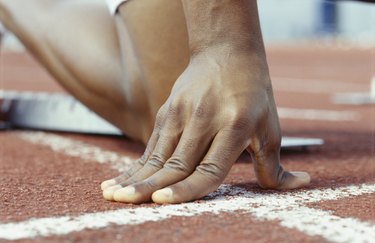
No other race in track and field is as awkward as the 800-meter run. It's stuck in a strange middle ground between an all-out sprint and the cruising pace of a distance race.
In two full laps around the track you can't sprint at the same pace you would a 400-meter run, but it has the sense of urgency that distance races lack. To improve your 800 time, you'll have to sprint, run distances, lift weights and practice plyometrics.
Video of the Day
Video of the Day
Running Workouts
Track workouts are the most important part of training for a track race. You can lift weights and run up hills as much as you want, but you need to practice the actual event to get better at it.
However, you don't want to simply run the 800M over and over again in training. Running shorter and longer distances will help you get faster and build endurance. It's the combination of speed and endurance that will make you better at this hybrid race.
Sprints
Practicing distances shorter than the 800 helps build speed. Start with a 30-meter run. When you start your race you have to accelerate quickly up to your cruising speed. The first thirty meters are used to get up to speed as quickly as possible. You can practice this in sets of ten, accelerating as quickly as possible and then jogging back to the start line.
The 300-meter sprint is a good gauge of your speed. You can run the 300 as fast as possible and then jog across the track to the start line and do it again. Try to run at the same pace for as many sprints as possible.
Your rest period should only be about a minute, which is just enough time to jog over to the starting line and catch your breath.
Read More: Techniques for Running 800 Meters
Distance Training
Quick sprinting ability is only half the battle in the 800. You also need to be able to maintain your speed, which is when endurance training comes in. The easiest way to train for endurance is to run longer distances, like the mile. You can also practice sprints, like the 100-meter, at a lower intensity. Instead of doing a series of sprints as fast as you can and then calling it a day, you would do 10 to 20 sprints just below your top speed, with very little rest.

The Weight Room
Running on the track is the most important part of training, but you need to add in other things to help you run faster. The weight room has plenty of tools to make your legs, the engine of your race, stronger. Moves like back squats work your legs and hips, which are the most important muscles for running. Getting stronger in this movement will improve your speed, according to a 2013 study in the Journal of Science and Medicine and Sport.
Other weight training exercises, like leg presses and lunges, will help you chip away at your 800M time. Anything that adds muscle and strength to your legs is worth doing.
Read More: 800 Meter Dash Training
Plyometrics
Another type of exercise that helps sprinters is plyometrics, or jump training. Weights build strength but plyometrics build speed.You can do vertical box jumps, trying to get as high as possible each time. Jumping forwards as far as you can will also help since it's similar to a sprinting motion. As you get better in plyometrics training you can practice jumping forwards as far as you can on one leg, which is even more specific to sprinting than jumping on two legs.
When you practice plyometrics, the goal is not to do a lot of repetitions. Instead, you should focus on being as explosive as possible for around five reps, and only do five sets during training. Because plyometrics are so intense and powerful your risk for injury is higher than lifting weights or sprinting, so be sure to take things slow when you start.
- Journal of Strength and Conditioning Research: The Effects of Plyometric Training on Sprint Performance: A Meta-Analysis
- Research Gate: Adaptations in Athletic Performance after Ballistic Power versus Strength Training
- Everything Track and Field: The 800 Meter
- Track Star USA: 800M Workouts
- Speed Endurance: How to Break 2:00 for 800M